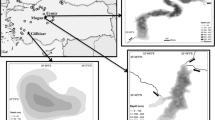Abstract
We sampled living and subfossil phantom midge (Diptera: Chaoboridae) larvae from surface sediments of 21 small lakes in Southern Sweden to examine the influence of fish and selected abiotic variables on the abundance and species composition of chaoborid assemblages. We expected total Chaoborus abundance to be inversely correlated with fish abundance and Chaoborus species most sensitive to fish predation to be found only in fishless lakes. We aimed to use the observed relationships to develop models to reconstruct past fish abundances from chaoborid remains and the abiotic environment. C. flavicans occurred in almost every lake, whereas subfossil C. obscuripes were found in the surface sediments of only one fishless lake. The density of living C. flavicans larvae correlated negatively with fish abundance, lake order and size. The concentration of C. flavicans subfossils was negatively associated with pH, lake size, water transparency and fish abundance. Regression models that included lake morphometry and landscape position as additional predictors of fish abundance performed better than models that used only Chaoborus predictors. The explained variance in fish abundance varied from 52 to 86%. Leave-one-out cross-validation indicated moderate performance of the two best models. These models explained 51 and 56% of the observed untransformed fish density and biomass, respectively. In addition, all Chaoborus models were unbiased in closely following the 1:1 reference line in plots of observed versus predicted values. These results are a promising step in developing midge-based paleolimnological reconstructions of past fish abundance, and the approach might be improved by including chironomid remains in the models.





Similar content being viewed by others
References
Akaike H (1974) A new look at the statistical model identification. IEEE T Automat Contr 19:716–723
Amsinck SL, Jeppesen E, Landkildehus F (2005) Relationships between environmental variables and zooplankton subfossils in the surface sediments of 36 shallow coastal brackish lakes with special emphasis on the role of fish. J Paleolimnol 33:39–51
Angeler DG, Goedkoop W (2010) Biological responses to liming in boreal lakes: an assessment using plankton, macroinvertebrate and fish communities. J Appl Ecol 47:478–486
Angeler DG, Johnson RK, Goedkoop W (2010) Understanding the role of lake history in liming management: a structural and functional comparison of multiple communities. Swedish University of Agricultural Sciences. Department of Aquatic Sciences and Assessment Report 2010:18, p 34
Appelberg M (1998) Restructuring of fish assemblages in Swedish lakes following amelioration of acid stress through liming. Restor Ecol 6:343–352
Appelberg M (2000) Swedish standard methods for sampling freshwater fish with multi-mesh gillnets. Fiskeriverket inform 1:3–32
Berendonk TU (1999) Influence of fish kairomones on the ovipositing behavior of Chaoborus imagines. Limnol Oceanogr 44:454–458
Berendonk TU, Bonsall MB (2002) The phantom midge and a comparison of metapopulation structures. Ecology 83:116–128
Blumenshine SC, Lodge DM, Hodgson JR (2000) Gradient of fish predation alters body size distributions of lake benthos. Ecology 81:374–386
Borcard D, Legendre P, Drapeau P (1992) Partialling out the spatial component of ecological variation. Ecology 73:1045–1055
Brabrand Å, Faafeng BA, Nilssen JPM (1990) Relative importance of phosphorus supply to phytoplankton production: fish excretion versus external loading. Can J Fish Aquat Sci 47:364–372
Breukelaar AW, Lammens EHRR, Klein Breteler JGP, Tátrai I (1994) Effects of benthivorous bream (Abramis brama) and carp (Cyprinus carpio) on sediment resuspension and concentrations of nutrient and chlorophyll a. Freshw Biol 32:113–121
Brodersen KP, Quinlan R (2006) Midges as paleoindicators of lake productivity, eutrophication and hypolimnetic oxygen. Quart Sci Rev 25:1995–2012
Brodin Y-W, Kuylenstierna JCI (1992) Acidification and critical loads in Nordic Countries: a background. Ambio 21:332–338
CEN (2005) European Standard EN 14 757 (2005) Water quality—sampling of fish with multimesh gillnets, CEN TC 230, March 2005
Davidson TA, Sayer CD, Perrow MR, Tomlinson ML (2003) Representation of fish communities by scale sub-fossils in shallow lakes: implications for inferring percid-cyprinid shifts. J Paleolimnol 30:441–449
Davidson TA, Sayer CD, Perrow M, Bramm M, Jeppesen E (2010) The simultaneous inference of zooplanktivorous fish and macrophyte density from subfossil cladoceran assemblages: a multivariate regression tree approach. Freshw Biol 55:546–564
Dawidowicz P, Pijanowska J, Ciechomski K (1990) Vertical migration of Chaoborus larvae is induced by the presence absence of fish. Limnol Oceanogr 35:1631–1637
Efron B, Gong G (1983) A leisurely look at the bootstrap, the jackknife, and cross-validation. Am Stat 37:36–48
Garcia EA, Mittelbach GG (2008) Regional coexistence and local dominance in Chaoborus: species sorting along a predation gradient. Ecology 89:1703–1713
Gliwicz ZM, Biernacka A, Pijanowska J, Korsak R (2000) Ontogenetic shifts in the migratory behaviour of Chaoborus flavicans Meigen: field and experimental evidence. Arch Hydrobiol 149:193–212
Grubbs F (1969) Procedures for detecting outlying observations in samples. Technometrics 11:1–21
Guhrén M, Bigler C, Renberg I (2007) Liming placed in a long-term perspective: a paleolimnological study of 12 lakes in the Swedish liming program. J Paleolimnol 37:247–258
Håkanson L (1981) A manual of lake morphometry. Springer, Berlin, p 78
Hammill E, Beckerman AP (2010) Reciprocity in predator-prey interactions: exposure to defended prey and predation risk affects intermediate predator life history and morphology. Oecologia 163:193–202
Hershey AE (1987) Tubes and foraging behavior in larval Chironomidae: implications for predator avoidance. Oecologia 73:236–241
Holmgren K, Appelberg M (2000) Size structure of benthic freshwater fish communities in relation to environmental gradients. J Fish Biol 57:1312–1330
Horppila J, Eloranta P, Liljendahl-Nurminen A, Niemistö J, Peckan-Hekim Z (2008) Refuge availability and sequence of predators determine the seasonal succession of crustacean zooplankton in a clay-turbid lake. Aquat Ecol 43:91–103
Jeppesen E, Madsen EA, Jensen JP, Anderson NJ (1996) Reconstructing the past density of planktivorous fish and trophic structure from sedimentary zooplankton fossils: a surface sediment calibration data set from shallow lakes. Freshw Biol 36:115–127
Johansson K, Nyberg P (1981) Acidification of surface waters in Sweden—effects and extend 1980. Inf Inst Freshwat Res Drottningholm 6: 188 (In Swedish with English summary)
Kålas S (1995) The ecology of ruffe, Gymnocephalus cernuus (Pisces: Percidae) introduced to Mildevatn, western Norway. Environ Biol Fish 42:219–232
Krauss J, Steffan-Dewenter I, Tscharntke T (2003) Local species immigration, extinction, and turnover of butterflies in relation to habitat area and habitat isolation. Oecologia 137:591–602
Kullback S, Leibler RA (1951) On information and sufficiency. Ann Math Stat 22:79–86
Kurek J, Cwynar LC, Weeber RC, Jeffries DS, Smol JP (2010) Ecological distributions of Chaoborus species in small, shallow lakes from the Canadian Boreal Shield ecozone. Hydrobiologia 652:207–221
Lamontagne S, Schindler DW (1994) Historical status of fish populations in Canadian rocky mountain lakes inferred from subfossil Chaoborus (Diptera: Chaoboridae) mandibles. Can J Fish Aquat Sci 51:1376–1383
Liljendahl-Nurminen A, Horppila J, Lampert W (2008) Physiological and visual refuges in a metalimnion: an experimental study of effects of clay turbidity and an oxygen minimum on fish predation. Freshw Biol 53:945–951
Luecke C (1990) Changes in abundance and distribution of benthic macroinvertebrates after introduction of cutthroat trout into a previously fishless lake. Trans Am Fish Soc 119:1010–1021
Mehner T, Diekmann M, Brämick U, Lemcke R (2005) Composition of fish communities in German lakes as related to lake morphometry, trophic state, shore structure and human-use intensity. Freshw Biol 50:70–85
Mouquet N, Loreau M (2003) Community patterns in source-sink metacommunities. Am Nat 162:544–557
Neill WE, Peacock A (1980) Breaking the bottleneck: interactions of invertebrate predators and nutrient in oligotrophic lakes. In: Kerfoot WC (ed) Evolution and ecology of zooplankton communities. New England Press, Hanover, pp 715–724
Olden JD, Jackson DA, Peres-Neto PR (2001) Spatial isolation and fish communities in drainage lakes. Oecologia 127:572–585
Olin M, Rask M, Ruuhijärvi J, Kurkilahti M, Ala-Opas P, Ylönen O (2002) Fish community structure in mesotrophic and eutrophic lakes of southern Finland: the relative abundances of percids and cyprinids along a trophic gradient. J Fish Biol 60:593–612
Olin M, Kurkilahti M, Peitola P, Ruuhijärvi J (2004) The effects of fish accumulation on the catchability of multimesh gillnet. Fish Res 68:135–147
Palm F, Svensson J-A (2010) Subfossil Chaoborus mandibles confirm historical fish decline in two acidified lakes, SW Sweden. Fundam Appl Limnol 177:313–320
Quinlan R, Smol JP (2010a) The extant Chaoborus assemblage can be assessed using subfossil mandibles. Freshw Biol 55:2458–2467
Quinlan R, Smol JP (2010b) Use of subfossil Chaoborus mandibles in models for inferring past hypolimnetic oxygen. J Paleolimnol 44:43–50
Quinlan R, Paterson AM, Hall RI, Dillon PJ, Wilkinson AN, Cumming BF, Douglas MSV, Smol JP (2003) A landscape approach to examining spatial patterns of limnological variables and long-term environmental change in a southern Canadian lake district. Freshw Biol 48:1676–1697
Rangel TF, Diniz-Filho JAF, Bini LM (2010) A comprehensive application for spatial analysis in macroecology. Ecography 33:1–5
Rask M, Mannio J, Forsius M, Posch M, Vuorinen PJ (1995) How many fish populations in Finland are affected by acid precipitation? Environ Biol Fish 42:51–63
Riera JL, Magnusson JJ, Kratz TK, Webster KE (2000) A geomorphic template for the analysis of lake districts applied to the Northern Highland Lake District, Wisconsin, USA. Freshw Biol 43:301–318
Roozen FCJM, Lürling M, Vlek H, Van der Pouw Kraan EAJ, Ibelings BW, Scheffer M (2007) Resuspension of algal cells by benthivorous fish boosts phytoplankton biomass and alters community structure in shallow lakes. Freshw Biol 52:977–987
Sæther OA (1997) Diptera Chaoboridae, phantom midges. In: Nilsson A (ed) Aquatic insects of North Europe. A taxonomic handbook, vol 2, Odonata-Diptera, pp 149–161
Schaeffer DL (1980) A model evaluation methodology applicable to environmental assessment models. Ecol Model 8:275–295
Scheffer M, Portielje R, Zambrano L (2003) Fish facilitate wave resuspension of sediment. Limnol Oceanogr 48:1920–1926
Schilling EG, Loftin CS, Degoosh KE, Huryn AD, Webster KE (2008) Predicting the locations of naturally fishless lakes. Freshw Biol 53:1021–1035
Stenson JAE (1981) The role of predation in the evolution of morphology, behavior and life history of two species of Chaoborus. Oikos 37:323–327
Sweetman JN, Smol JP (2006) Reconstructing fish populations using Chaoborus (Diptera: Chaoboridae) remains—a review. Quat Sci Rev 25:2013–2023
Tolonen KT, Hämäläinen H, Holopainen IJ, Mikkonen K, Karjalainen J (2003) Body size and substrate association of littoral insects in relation to vegetation structure. Hydrobiologia 499:179–190
Uutala AJ (1990) Chaoborus (Diptera: Chaoboridae) mandibles—palaeolimnological indicators of the historical status of fish populations in acid-sensitive lakes. J Paleolimnol 4:139–151
Uutala AJ, Smol JP (1996) Palaeolimnological reconstructions of long-term changes in fisheries status in Sudbury area lakes. Can J Fish Aquat Sci 53:174–180
Vinni M, Horppila J, Olin M, Ruuhijärvi J, Nyberg K (2000) The food, growth and abundance of five co-existing cyprinids in lake basins of different morphometry and water quality. Aquat Ecol 34:421–431
von Ende CN (1979) Fish predation, interspecific predation, and the distribution of two Chaoborus species. Ecology 60:119–128
Walker IR, Fernando CH, Paterson CG (1985) Associations of Chironomidae (Diptera) of shallow, acid, humic lakes and bog pools in Atlantic Canada, and a comparison with an earlier palaeoecological investigation. Hydrobiologia 120:11–22
Wissel B, Yan ND, Ramcharan CW (2003a) Predation and refugia: implications for Chaoborus abundance and species composition. Freshw Biol 48:1421–1431
Wissel B, Boeing WJ, Ramcharan CW (2003b) Effect of water colour on predation regimes and zooplankton assemblages in freshwater lakes. Limnol Oceanogr 48:1965–1976
Yan ND, Nero RW, Keller W, Lasenby DC (1985) Are Chaoborus larvae more abundant in acidified than in non-acidified lakes in Central Canada? Holarct Ecol 8:93–99
Acknowledgments
We thank Anne Jacobsen for help with sediment analyses and Prof. Roger Jones for comments and help with the English language. Critical comments of two anonymous reviewers and Mark Brenner were most useful. The study was supported by grants from Kone Foundation and Maa- ja vesitekniikan tuki ry.
Author information
Authors and Affiliations
Corresponding author
Rights and permissions
About this article
Cite this article
Tolonen, K.T., Brodersen, K.P., Kleisborg, T.A. et al. Phantom midge-based models for inferring past fish abundances. J Paleolimnol 47, 531–547 (2012). https://doi.org/10.1007/s10933-012-9579-4
Received:
Accepted:
Published:
Issue Date:
DOI: https://doi.org/10.1007/s10933-012-9579-4




